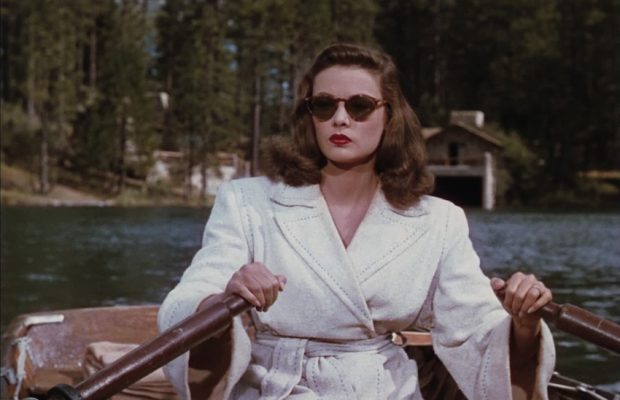Leave Her to Heaven (1945)
By on August 14, 2017
 |
Leave Her to Heaven (1945)
Running Time: 110 Minutes
Dir. John M. Stahl
Cast: Gene Tierney, Cornel Wilde, Jeanne Crain, Vincent Price
Genre: Drama, Romance
Screening Time: Monday, August 14th at 8:35 p.m. |
Storyline
A great-looking melodrama with the gorgeous Tierney as an irrational bride who goes to tragic ends to hold her husband’s total attention. Oscar-winning cinematography enhances stunning set decoration and art design. |


Based on a novel by Ben Ames Williams, LEAVER HER TO HEAVEN is a stunning 40s film, filled with spectacular set decorations and Oscar-winning color cinematography.
The story is a solid melodrama about beautiful Ellen Berent (Gene Tierney in her Oscar-nominated performance) who marries a naive novelist (Cornel Wilde). He is drawn into her family on the eve of the ceremonial scattering of her father's ashes in New Mexico. From the getgo the family seems full of angst as everyone stays out of Ellen's way. On a whim, she breaks her engagement to a lawyer (Vincent Price) and marries Wilde.
Everything seems OK until they visit his crippled brother (Darryl Hickman) in Georgia. She seems jealous of Wilde's attention to the kid. Somehow, plans are made for the three of them to go to Wilde's "lodge" in Maine, where a faithful servant )Chill Wills) also lives. Tierney seems more and more edgy and starts to openly resent Hickman and Wills. And then her mother a step sister (Mary Philips, Jeanne Crain) arrive from Bar Harbor.
Everything starts to unravel at this point as Tierney becomes convinced that Wilde and falling for Crain. A series of mysterious accidents happen and there is a big (overblown) court case tried by the man (Price) she dumped to marry Wilde and a stunning turn of events.
The movie is gloriously filmed in rich Technicolor that accentuates deep reds, warm golds, and luscious shades of turquoise. The Maine and New Mexico interiors are just great and look like they came out of a contemporary magazine, including the simple little lodge by the lake. Also of note is the driving dramatic score by Alfred E. Newman.
Tierney is superb as the troubled Ellen and has never looked more beautiful. Wilde is suitable perplexed as the the novelist. Crain is solid as the stalwart sister. Price overacts outrageously (but it's fun). Philips, Wills, and Hickman are good. Others in the cast include Ray Collins, Olive Blakeney, Gene Lockhart, Mae Marsh, Grant Mitchell, and Reed Hadley.
LEAVE HER TO HEAVEN ranks among the best melodramas of the 1940s.
While most film noirs conjure up images of terror in black-and-white settings, ‘Leave Her To Heaven’ manages to fall into the noir category despite its lush technicolor scenery and handsome interiors. It’s a visually stunning example of "women’s noir" performed to the hilt by a talented cast. Only Cornel Wilde fails to deliver. He seems too weak as the author who impulsively marries a beautiful woman, only to find that beneath the lovely exterior is a warped mind consumed by jealousy. He never quite measures up to Tierney’s performance–seemingly sweet and kind but actually cold and cunning. Tierney has never been more beautifully photographed and looks stunning throughout. Jeanne Crain does well enough as the demure half-sister, rising to the occasion when the script demands a spunkier side to her personality. While the plot gets a little "heavy" at times, it’s a supremely satisfying melodrama played against some of the most beautiful settings imaginable. Alfred Newman’s music suggests the slowly developing tension. All in all, a fascinating example of film noir that succeeds despite technicolor. Another fine example of color noir might be ‘Chinatown’. Well worth seeing to watch a fascinating femme fatale at work. Gene Tierney deserved her Oscar nomination–but lost to Joan Crawford of ‘Mildred Pierce’.
No one can watch this without remembering Gene Tierney's searing blue eyes, Jeanne Crain's face of innocence, or Cornel Wilde (lightyears from The Naked Prey) here looking like a photo of Pierre & Gilles come to life. It's 110 minutes of color-time-travel basking in the surreally saturated Technicolor palette of the mid 40's.
For those who have been denied the experience of watching the recently restored version with a rapt audience on a big screen as happened April 26, 2008 at San Francisco's Castro Theatre, I can only hope you'll contact a film preservation-minded theater in your area.
Though I've watched this film on DVD, nothing prepared me for the impact of the big screen. The closeups alone will take your breath away.
Is it melodrama or is it noir?–leave that to Heaven!